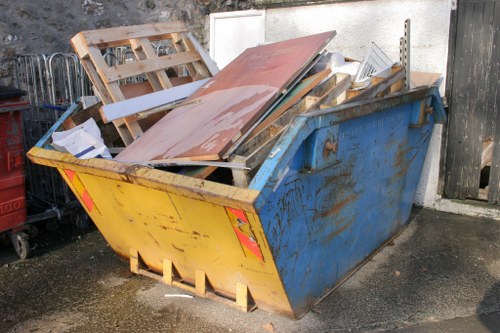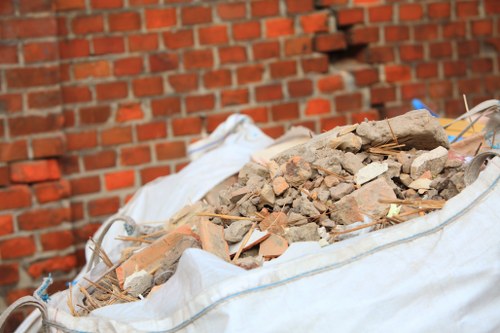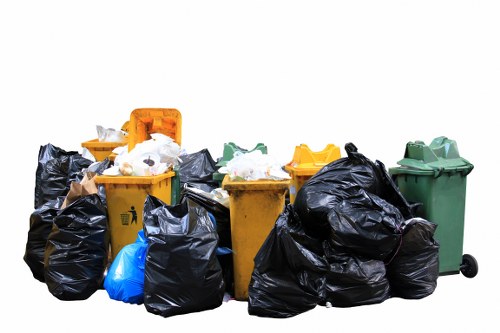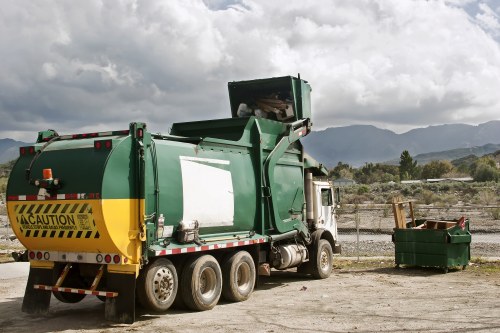Effective Waste Disposal in White Goods Recycling
Introduction to White Goods Recycling

White goods, encompassing major household appliances like refrigerators, washing machines, and ovens, play a pivotal role in daily life. However, their disposal poses significant environmental challenges due to the materials they contain and their volume. Proper waste disposal in white goods recycling not only mitigates environmental impact but also promotes the sustainable reuse of valuable resources.
As technology advances and consumer lifestyles evolve, the turnover rate of white goods continues to increase. This surge necessitates efficient recycling processes to handle the growing volume of discarded appliances. Understanding the intricacies of white goods recycling is essential for consumers, businesses, and policymakers alike.
In this article, we delve into the methods, benefits, and best practices associated with waste disposal in white goods recycling. We aim to provide a comprehensive overview that highlights the importance of responsible disposal and the positive effects it has on the environment and the economy.
Importance of Recycling White Goods

Recycling white goods is crucial for several reasons. Firstly, it significantly reduces the amount of waste that ends up in landfills. Appliances like refrigerators and washing machines contain materials such as metals, plastics, and glass that can be repurposed and reused in manufacturing new products.
Furthermore, proper recycling helps in conserving natural resources. By extracting and reusing materials from old appliances, there is less need to mine or produce new raw materials, thereby preserving ecosystems and reducing the carbon footprint associated with production processes.
Additionally, white goods recycling plays a role in energy conservation. Recycling metals, for instance, typically requires less energy compared to extracting and processing raw ore. This energy efficiency contributes to lower greenhouse gas emissions, aligning with global efforts to combat climate change.
Environmental Benefits

The environmental benefits of recycling white goods are multifaceted. By diverting electronic waste from landfills, we prevent the leaching of harmful chemicals and metals into soil and water sources. Components like refrigerants, lead, and mercury can pose serious environmental and health risks if not properly handled.
Recycling also reduces the demand for virgin materials, which in turn decreases deforestation, habitat destruction, and the depletion of non-renewable resources. This sustainable approach fosters a circular economy where materials are continuously repurposed, minimizing waste generation.
Moreover, white goods recycling contributes to reducing air pollution. Manufacturing from recycled materials typically emits fewer pollutants compared to producing goods from raw materials. This reduction in emissions supports cleaner air quality and mitigates the adverse effects of industrial activities on the environment.
Economic Advantages

Beyond environmental impacts, recycling white goods offers substantial economic benefits. The recycling industry creates jobs in collection, sorting, processing, and manufacturing sectors. These employment opportunities contribute to the economy and support community development.
Additionally, recycling can be cost-effective for both consumers and businesses. For consumers, recycling programs often provide incentives or reduce disposal fees, making it financially beneficial to participate in recycling efforts.
Businesses involved in recycling gain access to a steady supply of raw materials, which can lower production costs and enhance profitability. Moreover, companies that prioritize sustainability through recycling can improve their market reputation, attracting environmentally conscious consumers and investors.
Recycling Process for White Goods

The recycling process for white goods involves several key steps to ensure effective waste disposal and material recovery. Understanding each stage helps in appreciating the complexity and importance of proper recycling practices.
1. Collection and Transportation: Appliances are collected from households, businesses, and recycling centers. Efficient transportation logistics are crucial to minimize environmental impact during this stage.
2. Dismantling and Sorting: Once at the recycling facility, white goods are dismantled. Components are sorted into categories such as metals, plastics, glass, and electronic parts. This separation is vital for the subsequent recycling processes.
Advanced Recycling Technologies
Modern Techniques in Material Recovery

Advancements in recycling technologies have enhanced the efficiency and effectiveness of white goods recycling. Techniques such as automated dismantling, magnetic separation, and chemical processing allow for more precise material recovery.
For example, automated dismantling systems can quickly disassemble appliances, separating components without significant manual intervention. This increases processing speed and reduces labor costs.
Chemical processing methods enable the extraction of specific materials, such as rare metals, with higher purity levels. These advanced techniques ensure that recycled materials meet quality standards required for manufacturing new products.
Sustainable Practices
Implementing Eco-Friendly Recycling Strategies

Adopting sustainable practices in white goods recycling is essential for maximizing environmental benefits. Key strategies include:
- Design for Recycling: Manufacturers can design appliances with recycling in mind, using materials that are easier to separate and process.
- Extended Producer Responsibility (EPR): Policies that hold producers accountable for the end-of-life disposal of their products encourage manufacturers to create more sustainable designs.
- Consumer Education: Informing consumers about the importance of recycling and how to properly dispose of white goods ensures higher participation rates and better recycling outcomes.
Challenges in White Goods Recycling
Overcoming Barriers to Effective Recycling

Despite the benefits, white goods recycling faces several challenges that need to be addressed to improve efficiency and effectiveness.
1. Complexity of Appliances: Modern white goods often contain a multitude of materials and complex components, making the recycling process labor-intensive and technologically demanding.
2. Contamination: Improper disposal can lead to contamination of recyclable materials. For instance, mixing different types of plastics can complicate the recycling process and reduce the quality of recycled products.
Regulatory Framework
Policies and Standards Governing Recycling

Effective white goods recycling relies on robust regulatory frameworks that establish guidelines and standards for disposal and recycling practices.
Regulations such as the Waste Electrical and Electronic Equipment (WEEE) Directive in the European Union set requirements for the collection, recycling, and recovery of electronic waste, including white goods. Similar policies exist in various countries to promote responsible recycling and minimize environmental impact.
Compliance with these regulations ensures that recycling facilities adhere to best practices, safeguarding environmental and public health while promoting sustainability.
Consumer Role in Recycling
How Individuals Can Contribute

Consumers play a critical role in the success of white goods recycling programs. By making informed decisions and actively participating in recycling efforts, individuals can significantly impact environmental sustainability.
Key actions include:
- Proper Disposal: Ensure that old appliances are disposed of through authorized recycling channels rather than trashing them.
- Donation and Resale: If appliances are still functional, consider donating or selling them to extend their lifespan before recycling.
- Supporting Sustainable Brands: Choose products from manufacturers that prioritize sustainability and offer take-back programs for end-of-life disposal.
Benefits of Professional Recycling Services
Why Choose Experts for Waste Disposal

Opting for professional recycling services ensures that white goods are handled responsibly and efficiently. These services offer expertise in dismantling, sorting, and processing appliances, maximizing material recovery and minimizing environmental impact.
Additionally, professional recyclers adhere to regulatory standards, ensuring compliance and reducing the risk of improper disposal. They often provide convenient collection and transportation options, making it easier for consumers to participate in recycling programs.
Moreover, professional services contribute to the economy by creating jobs and supporting the recycling industry, further reinforcing the benefits of sustainable waste disposal practices.
Innovations in White Goods Recycling
Future Trends and Technologies

The field of white goods recycling is continually evolving, with innovations aimed at improving efficiency and sustainability. Emerging technologies and methodologies are set to revolutionize the way we handle appliance waste.
For instance, advanced robotics and AI are being integrated into recycling facilities to enhance the sorting and dismantling processes. These technologies increase precision, reduce human error, and speed up operations, leading to higher material recovery rates.
Additionally, chemical recycling methods are being developed to break down complex materials into their basic components, facilitating the creation of high-quality recycled materials suitable for various applications.
Case Studies
Successful White Goods Recycling Programs

Examining successful white goods recycling programs provides valuable insights into effective waste disposal strategies.
Example 1: Sweden's Circular Economy Model - Sweden has implemented a comprehensive circular economy approach, emphasizing recycling and reuse. Their national recycling system ensures that white goods are efficiently collected, processed, and reintegrated into the manufacturing cycle.
Example 2: Japan's Eco-Friendly Initiatives - Japan has introduced innovative recycling technologies and policies that encourage the reduction of waste and the enhancement of material recovery. Their focus on technological advancement and regulatory support sets a benchmark for other countries.
Best Practices for Effective Recycling
Guidelines to Optimize Waste Disposal

Implementing best practices in white goods recycling ensures optimal waste disposal and resource recovery.
Key best practices include:
- Comprehensive Collection Systems: Establish robust collection networks that are accessible to all consumers, ensuring higher participation rates.
- Efficient Sorting and Processing: Utilize advanced sorting technologies to accurately separate materials, enhancing the quality and value of recycled outputs.
- Public Awareness Campaigns: Educate the public on the importance of recycling and provide clear instructions on how to dispose of white goods responsibly.
- Collaboration with Stakeholders: Foster partnerships between governments, businesses, and communities to support recycling initiatives and share resources.
- Continuous Improvement: Regularly assess and refine recycling processes to incorporate new technologies and address emerging challenges.
Challenges and Solutions
Addressing Obstacles in White Goods Recycling

While white goods recycling offers numerous benefits, several challenges must be addressed to enhance its effectiveness.
Challenge 1: High Initial Costs - The setup and operation of recycling facilities require significant investment. To overcome this, governments can offer subsidies and incentives to encourage the establishment of recycling infrastructure.
Challenge 2: Limited Consumer Participation - Low awareness and convenience issues can hinder recycling efforts. Implementing more accessible collection points and conducting educational campaigns can boost participation rates.
Challenge 3: Technological Limitations - Existing recycling technologies may not efficiently handle all types of white goods. Investing in research and development can lead to the creation of more advanced and versatile recycling solutions.
Future Outlook
The Path Forward for White Goods Recycling

The future of white goods recycling is promising, with ongoing advancements aimed at enhancing sustainability and efficiency. Embracing innovation and fostering a collaborative approach among stakeholders will be key to overcoming current challenges and achieving long-term goals.
As global awareness of environmental issues grows, the demand for effective recycling solutions will continue to rise. This trend will drive further investments in recycling technologies and infrastructure, enabling more comprehensive and effective waste disposal practices.
Furthermore, integrating circular economy principles into broader economic strategies will reinforce the importance of recycling and resource conservation, ensuring that white goods recycling remains a vital component of sustainable development.
Conclusion
Embracing Sustainable Waste Disposal

Waste disposal in white goods recycling is a critical aspect of environmental sustainability and resource conservation. By adopting effective recycling practices, we can reduce waste, conserve natural resources, and promote a healthier planet.
However, achieving optimal recycling outcomes requires the collective efforts of consumers, businesses, and policymakers. Through education, investment in technology, and supportive regulations, we can overcome the challenges and unlock the full potential of white goods recycling.
Take action today to contribute to a sustainable future. Contact us today to learn more about white goods recycling solutions and how you can participate in responsible waste disposal practices.